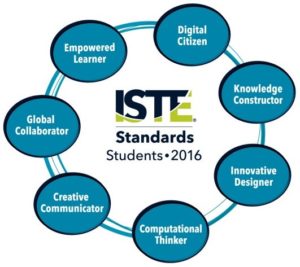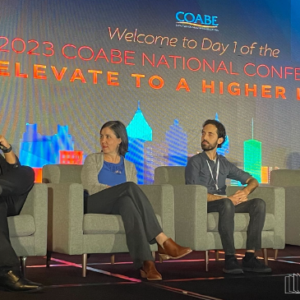The International Society for Technology in Education (ISTE) is well known in the K-12 world as a thought leader on the issue of digital literacy. Their digital literacy standards, first shared in 1998, have been continuously revised to keep apace with both changes in technology and increased expectation for embedded technology use in teaching and learning. The current ISTE student standards reflect the move toward personalized learning opportunities that leverage technology to amplify learning – not just use technology to support it. This is important because we live in a rapidly changing world. To meet the demands of the future, today’s students need to learn how to quickly respond to changes in environment. They need to recognize when they have something to learn and feel empowered to seek out information and build knowledge. The current ISTE standards, released in 2016, attempt to empower student voice and ensure that learning is student-driven – providing opportunities for students to become self-agentic learners.
“Today’s students must be prepared to thrive in a constantly evolving technological landscape.”
 At first look, it’s perhaps hard to connect these standards to what is often thought of as “digital literacy” in adult basic education (ABE). The ISTE student standards are a description of the skills, aptitudes, and beliefs required to thrive in the 21st Century. Indeed they describe perfectly the characteristics of a successful, well-educated, civically engaged learner ready to matriculate into higher-education or find a job and succeed at work. Students who succeed in their K-12 schooling will be well-situated to do so if their learning opportunities are driven by these standards.
At first look, it’s perhaps hard to connect these standards to what is often thought of as “digital literacy” in adult basic education (ABE). The ISTE student standards are a description of the skills, aptitudes, and beliefs required to thrive in the 21st Century. Indeed they describe perfectly the characteristics of a successful, well-educated, civically engaged learner ready to matriculate into higher-education or find a job and succeed at work. Students who succeed in their K-12 schooling will be well-situated to do so if their learning opportunities are driven by these standards.
But what about the learners who do not finish high school? Or learners who may graduate but experience barriers that inhibit development of the characteristics implicit in the standards both before and after graduation? These learners need to develop resilience in a constantly shifting technological landscape too, yet the teachers who support them as they struggle to graduate or persist in adult basic education programs likely find it a challenge to realize the new ISTE standards in their instruction. This is a dangerous reality given increasing reliance on sophisticated technologies in even entry-level work.
We have made progress in ABE moving the needle on what is considered digital literacy. Though many programs are yet focusing on basic computer skills and leaving it there, others have begun to realize the importance of embracing a problem-solving process that provides opportunities for learners to apply computer skills to support learning, finding information, and accomplishing scaffolded tasks in the classroom. This problem/task based approach is most commonly framed in ABE as Problem Solving in Technology-Rich Environments (PSTRE). This model, the problem-solving model for digital literacy in ABE, looks a lot like the old ISTE standards, which provided a foundation for application of technology to support learning and placed the teacher as the driver of what a student learns.
The shift to a problem-solving approach is a good start toward ensuring that learners have opportunities to learn to use new technologies; however, I’d argue that this is not quite enough. We need to move beyond considering imparting discrete technology skills (perhaps through an “I do” “We do” “You do” approach) and heavily scaffolded application activities to a more project-based approach that helps learners tackle authentic and relevant tasks requiring use of multiple technologies. In this way, they can not only learn and make use of technologies, they drive learning and build fluency choosing technologies and begin to develop confidence in taking on new technologies.
Read our previous post about ISTE Standards: Facing the Retail Revolution with Empowered Learning for Technology Skills
Jen Vanek, PhD, is the Director of Digital Learning and Research at the EdTech Center @ World Education. Through her research and direction of the Innovating Distance Education for Adult Learners (IDEAL) Consortium, she supports policy leaders, practitioners, and learners in adult basic education in the areas of digital literacy, online learning, career pathways, and English language learning.




